Morning of November 1: New cases and deaths in Russia are the highest in the world; The epidemic is spreading rapidly in China
According to the website worldometer.info, in the past 24 hours, the world recorded over 315,000 cases of COVID-19 and over 4,200 deaths. The total number of cases since the beginning of the epidemic has been over 247.4 million, of which over 5.01 million have died.
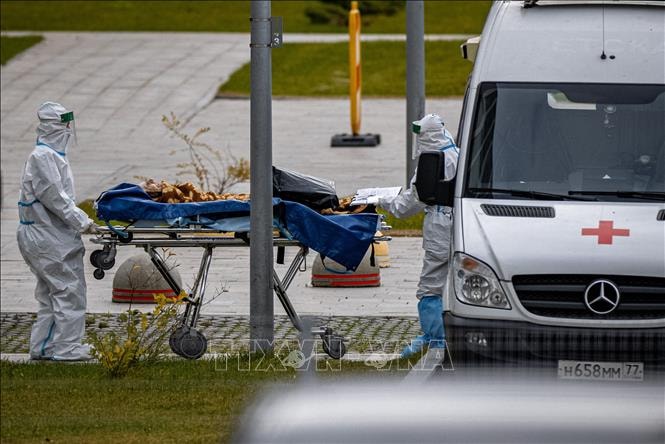 |
| Transferring a COVID-19 patient to Kommunarka hospital on the outskirts of Moscow, Russia. Photo: AFP/TTXVN |
The three countries with the highest number of deaths in the past 24 hours in the world are Russia (1,158 cases), Romania (394 cases) and Ukraine (336 cases).
Thus, Russia continues to lead the world in both the number of new cases and deaths. The number of new cases in Russia mentioned above is also a record high since the outbreak in this country. Russia is ranked 5th in the world in terms of total cases (over 8.5 million cases) and total deaths (over 238,000 cases).
Since the beginning of the pandemic, the US is still the country with the highest total number of COVID-19 cases and deaths in the world with over 46.8 million cases and over 766,000 deaths.
COVID-19 epidemic is spreading rapidly in China
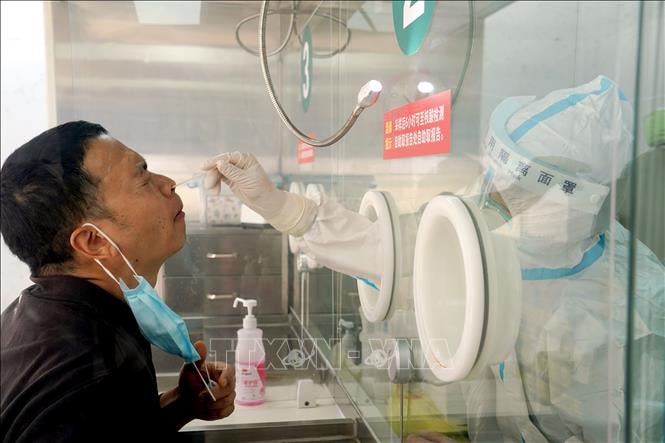 |
| Medical staff take COVID-19 test samples from people in Shanghai, China on October 30, 2021. Photo: THX/TTXVN |
According to statistics from the National Health Commission (NHC) of China, from October 17 to 29, the country recorded 377 new cases of COVID-19.
According to NHC spokesman Mi Feng, in the past 14 days, 14 provinces and cities in China have reported new cases of community transmission or asymptomatic infections. He admitted that "this outbreak is still evolving rapidly."
Heihe, a small city of 1.3 million people in northeastern China that borders Russia, reported 26 new cases on October 29, nearly triple the number from the day before. NHC officials said monitoring and gene sequencing showed the outbreak in Heihe was not related to the ongoing outbreak in northwest China, suggesting the source of infection may have come from abroad.
Last week, the NHC said that cases detected since October 17 in the country's northern and northwestern regions may have originated from abroad.
China’s border towns, which have relatively few resources, tend to be hit harder than larger cities when the outbreak hits. Authorities in major cities have pledged to strictly control major international events to minimize the risk of the virus being imported from outside.
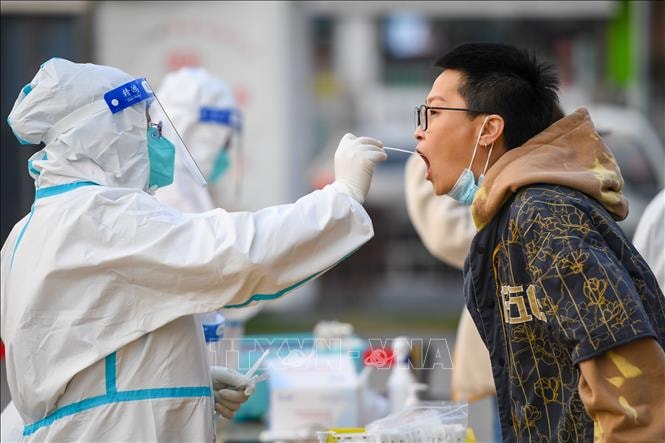 |
| Medical staff take COVID-19 test samples from people in Inner Mongolia Autonomous Region, China on October 29, 2021. Photo: THX/TTXVN |
Speaking during an inspection tour of Lanzhou and Tianshui cities in northwest China's Gansu Province, Vice Premier Sun Chunlan urged drastic and effective measures to control the resurgence of COVID-19 cases. She stressed the importance of strengthening nucleic acid testing and accelerating epidemiological investigations to prevent the spread of the SARS-CoV-2 virus. She said local authorities should make efforts to prevent imported cases and local outbreaks, and promote the construction of a public health emergency response system in western regions.
The number of infections in this outbreak in China is still low compared to many other countries. Currently, China still maintains a "Zero COVID-19" policy, strictly controlling border areas and seaports to prevent imported cases. To safely organize the Beijing Winter Olympics, scheduled to take place in February 2022, Chinese athletes and staff participating in the event must receive a booster shot of the vaccine, while foreign athletes are encouraged, but not required, to receive a third dose of the vaccine.
China aims to complete vaccinations for children aged 3-11 by the end of December. About 75.8% of the country's 1.4 billion people have completed vaccinations so far, and those eligible are receiving booster shots.
Meanwhile, the government of Harbin city, Heilongjiang province (Northeast China), on October 31 decided to stop in-person learning for kindergartens, primary and secondary schools for one week, starting from November 1, to control the COVID-19 epidemic. The decision was made after the Heilongjiang Provincial Health Department recorded 19 new cases of community transmission on October 30.
South Korea begins vaccinating 12- to 15-year-olds
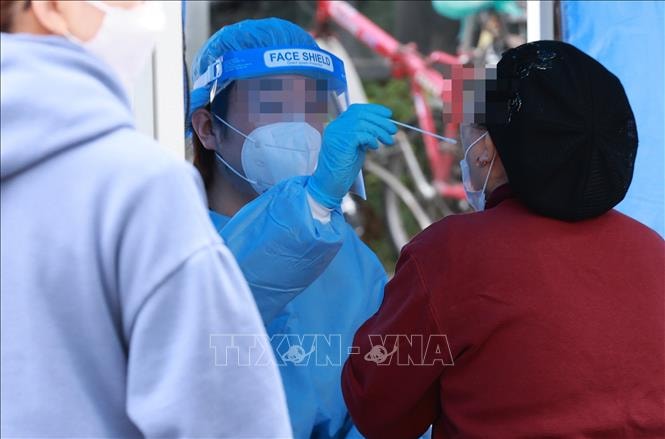 |
| Medical staff take COVID-19 test samples from people in Guro, South Korea on October 30, 2021. Photo: Yonhap/TTXVN |
From November 1, South Korea will start vaccinating children aged 12-15 with the Pfizer COVID-19 vaccine (children born between 2006 and 2009). This is one of the measures being applied to realize the 3-phase plan "Living with COVID" that the Korean Government has just announced. Also starting from November 1, South Korea will vaccinate immunocompromised patients such as leukemia patients, organ transplant patients and those taking immunosuppressants.
According to the National Center for Disease Control and Prevention, from October 18, Korea began accepting vaccination registrations for children aged 12-15, and as of October 30, the vaccination registration rate was quite low at 26.4%, equivalent to about 493,055 registered children. The vaccination registration rate for children may be affected by the recent death of a 10th grade student, 75 days after receiving the Pfizer vaccine on August 13. The cause of death has not yet been announced.
Laos plans to reopen schools nationwide
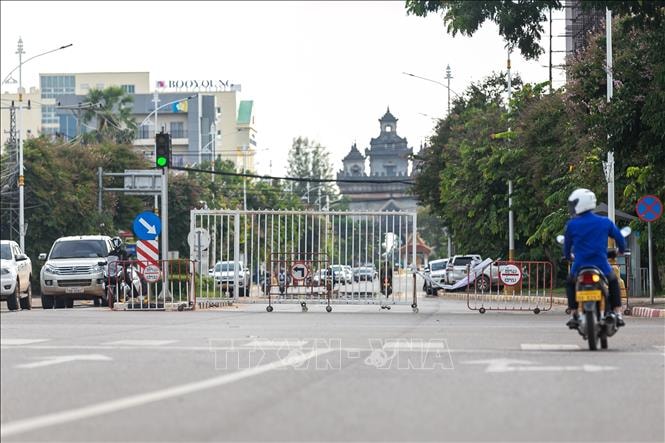 |
| Blocking a road to prevent the spread of COVID-19 in the capital Vientiane, Laos. Photo: THX/TTXVN |
The Lao government on October 31 decided to extend restrictive measures to prevent and control the epidemic until November 14, and at the same time planned to soon reopen schools across the country.
The announcement of the Lao Prime Minister's Office stated that in the context of the epidemic spreading in 17/18 provinces and cities across the country, with the number of new cases reaching over 500 people/day during the past October, an increase of 27.6% compared to September 2021, the extension of restrictive measures is necessary to ensure that Lao people and foreign citizens living in Laos are maximally protected from the pandemic, while helping to minimize deaths. The announcement emphasized that in parallel with restrictive measures, the government also has easing measures to create conditions for people to live in the new normal.
In areas with community transmission, the Lao Government will continue to strictly implement prevention and control measures. Factories in residential areas with community transmission in factories or residential areas must also close, except for those factories that have been permitted to operate by the COVID-19 Prevention and Control Committee.
In localities with no community transmission cases, educational institutions at all levels are allowed to open.
The announcement from the Lao Prime Minister's Office also requested the Ministry of Health to coordinate with the Ministry of Education and Sports to prepare measures and recommendations for the reopening of schools and educational institutions at all levels across the country; affirming that the reopening will only be allowed for schools that meet the necessary conditions and are permitted by the relevant provincial COVID-19 Prevention and Control Committee.
Cambodia launches vaccination campaign for 5-year-olds
The Cambodian National Committee for COVID-19 Vaccination announced that the vaccination campaign for 5-year-old children will officially start from November 1.
This will be the fifth consecutive vaccination campaign after the first phase started on February 10 for people over 18 years old; the second phase from August 1 for adolescents aged 12-17; from September 17 for children aged 6-12; while frontline forces against the epidemic were vaccinated with booster shots in early August. There is currently no announcement on the number of 5-year-old children vaccinated in this phase, but the fifth vaccination campaign shows Cambodia's determination to achieve the target of injecting at least one dose of COVID-19 vaccine for 91% of the country's 16 million people by the end of this year.
According to a report from the Cambodian Ministry of Health, for the first time since April, the number of infections recorded in the country has dropped below 100 cases per day. Specifically, in the past 24 hours, Cambodia recorded 95 new cases and 7 deaths. This is the 30th consecutive day of low new cases in the context of Cambodia implementing the "new normal state".
To date, the total number of cases in Cambodia is 118,522, including 2,788 deaths.
Australia eases border controls for first time since March 2020
On November 1, Australia began easing border restrictions imposed over the past 18 months, allowing about 14 million people in the country who have been fully vaccinated against COVID-19 in the states of Victoria, New South Wales and the capital Canberra to travel freely, including abroad and re-entering upon return.
About 47,000 Australian citizens and permanent residents overseas were also allowed to re-enter, bringing many families together for the first time since March last year.
After a long period of applying the strictest epidemic prevention and control measures in the world, Australia has now shifted from a "zero COVID" strategy to living with the SARS-CoV-2 virus through widespread vaccination activities. To date, more than 80% of people over 16 years old in the two largest states of Australia and the Australian Capital Territory (ACT) have been fully vaccinated, a condition for resuming international travel.
Australia closed its borders at the start of the pandemic and only allowed some citizens and permanent residents to return from overseas, with a mandatory 14-day hotel quarantine period.
Despite months of lockdown in Sydney and Melbourne, Australia’s COVID-19 caseload remains lower than many other countries, with over 170,500 cases and 1,735 deaths. To date, more than 77% of eligible Australians have been fully vaccinated against COVID-19, while more than 88% have received at least one dose.
US allows foreign children to enter without quarantine
On October 30, the US Centers for Disease Control and Prevention (CDC) announced that foreign travelers under 18 years old arriving in the US by plane do not need to self-quarantine after entering the country.
CDC Director Rochelle Walensky has signed a revised order to quarantine foreign children entering the US. Specifically, children under 18 who have not been vaccinated against COVID-19 do not need to self-quarantine for 7 days after entering the country. Previously, a CDC directive had made many foreigners worried that children would be required to quarantine for 1 week after arriving in the US.
From November 8, the US will also lift entry restrictions for most foreigners who have been to the UK, 26 Schengen countries, Ireland, China, India, South Africa, Iran and Brazil within the previous 14 days.
Airlines and other organizations have called on the CDC to change the rules for foreign children, arguing that requiring children to self-isolate upon arrival would impact international tourism. In addition to children, the quarantine exemption also applies to foreign nationals participating in medical trials.


